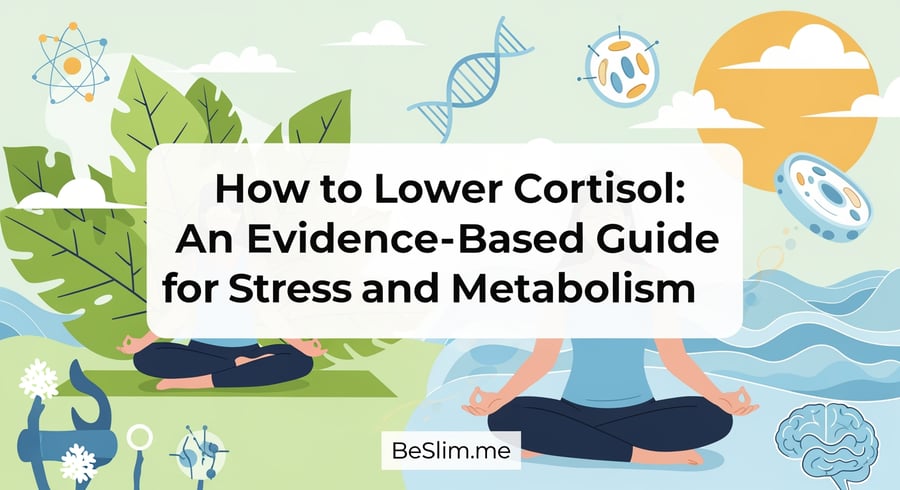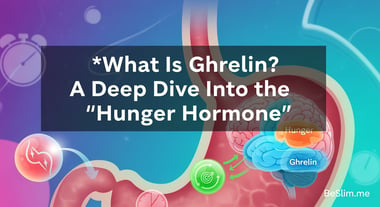Hello, I'm Master Kim, the founder and Chief Scientific Officer at BeSlim.me. I've spent years diving deep into the science of metabolism and stress, both through my research and personal journey helping countless individuals reclaim their health. If you're feeling overwhelmed by stress, noticing unexplained weight gain, or struggling with metabolic issues, I understand how frustrating that can be. High cortisol levels can sabotage your efforts, but the good news is there are proven ways to bring them down. In this guide, we'll explore how to lower cortisol effectively, drawing from evidence-based strategies that I've seen transform lives. Let's get you on the path to better balance—starting with the science.
Understanding Cortisol and Its Role in Stress and Metabolism
Cortisol, often called the "stress hormone," is a glucocorticoid produced by the adrenal glands. It's essential for survival, helping your body respond to stressors by mobilizing energy reserves. However, when cortisol remains elevated chronically, it can disrupt metabolism, leading to issues like insulin resistance, fat accumulation (especially around the abdomen), and weakened immune function. This happens because cortisol influences how your body processes glucose, fats, and proteins, prioritizing short-term survival over long-term health.
To grasp why lowering cortisol matters, consider its impact on daily life. Chronic stress—from work pressures, poor sleep, or unhealthy diets—keeps cortisol high, which can exacerbate conditions like anxiety, sleep disturbances, and even metabolic disorders such as type 2 diabetes. For those pursuing weight management or metabolic health, as we do at BeSlim.me, addressing cortisol is key because it directly affects how efficiently your body burns fat and regulates blood sugar.
Let's dive into the science behind this. The production of cortisol is regulated by the hypothalamic-pituitary-adrenal (HPA) axis, a complex feedback system involving the brain and adrenal glands. When a stressor is detected, the hypothalamus releases corticotropin-releasing hormone (CRH), which signals the pituitary gland to secrete adrenocorticotropic hormone (ACTH). ACTH then stimulates the adrenal cortex to produce cortisol. This hormone binds to glucocorticoid receptors in cells throughout the body, influencing gene expression that promotes gluconeogenesis (the creation of glucose from non-carbohydrate sources) and inhibits insulin's effects, leading to higher blood sugar levels.
In terms of metabolism, elevated cortisol promotes lipolysis in peripheral tissues but encourages fat storage in visceral areas, contributing to metabolic syndrome. Chronic elevation disrupts the HPA axis's negative feedback loop, where high cortisol should normally signal the hypothalamus to reduce CRH production. When this loop fails, it results in sustained high levels, amplifying stress responses and metabolic imbalances.
For visual clarity, a diagram of the HPA axis would be helpful here—illustrating the flow from hypothalamus to pituitary to adrenals, with arrows showing hormone release and feedback loops. This could make the mechanism easier to visualize and understand at a glance.
Biological Mechanisms of Cortisol Regulation
Delving deeper, the underlying biological mechanisms of cortisol involve intricate cell signaling pathways and hormone interactions. At the cellular level, cortisol exerts its effects by crossing the cell membrane and binding to intracellular glucocorticoid receptors (GRs). This cortisol-GR complex translocates to the nucleus, where it acts as a transcription factor, modulating the expression of genes involved in inflammation, metabolism, and immune response. For instance, it upregulates genes for enzymes like phosphoenolpyruvate carboxykinase (PEPCK), which drives gluconeogenesis in the liver, ensuring energy availability during stress.
However, chronic stress leads to glucocorticoid resistance, where cells become less responsive to cortisol's signals due to downregulation of GRs or interference from pro-inflammatory cytokines. This resistance perpetuates a cycle of elevated cortisol production, as the body compensates by producing more to achieve the same effects. In metabolic terms, this mechanism disrupts insulin signaling: cortisol inhibits the insulin receptor substrate-1 (IRS-1), reducing glucose uptake in muscles and fat tissues, which can lead to hyperglycemia and fat redistribution.
Another key aspect is cortisol's interaction with other hormones. It antagonizes insulin, promoting a catabolic state where proteins are broken down for energy, which can lead to muscle wasting over time. Additionally, cortisol influences the sympathetic nervous system, enhancing the release of catecholamines like adrenaline, which further amplifies the stress response through beta-adrenergic receptors on cells.
The mechanism of lowering cortisol often targets these pathways. For example, interventions that enhance GABAergic signaling in the brain can inhibit CRH release from the hypothalamus, breaking the cycle. Similarly, anti-inflammatory agents or lifestyle changes that reduce oxidative stress can restore GR sensitivity, allowing the negative feedback loop to function properly.
To enhance understanding, a simple comparison table could be useful here: one column for "High Cortisol Mechanisms" (e.g., upregulated gluconeogenesis, insulin resistance) and another for "Lowering Strategies" (e.g., mindfulness reducing CRH, exercise enhancing GR sensitivity). This table would provide a quick reference for readers to connect mechanisms with actions.
According to research, chronic stress elevates cortisol via HPA axis dysregulation, leading to metabolic disturbances like increased visceral fat.
Evidence-Based Strategies to Lower Cortisol
Now that we've covered the mechanisms, let's explore practical, evidence-based strategies to lower cortisol. These approaches target the HPA axis and cellular signaling to restore balance, supported by scientific studies.
First, mindfulness and meditation practices are highly effective. By activating the parasympathetic nervous system, they reduce CRH and ACTH secretion, directly lowering cortisol output. Techniques like mindfulness-based stress reduction (MBSR) have been shown to decrease cortisol levels by modulating amygdala activity, the brain's stress center. Start with 10-15 minutes daily of guided meditation to see benefits.
Physical activity, particularly moderate aerobic exercise, helps by increasing endorphin release and improving GR sensitivity. Exercise stimulates the production of brain-derived neurotrophic factor (BDNF), which supports neuronal health and dampens HPA axis overactivity. Aim for 30 minutes of brisk walking or yoga most days, but avoid overtraining, as excessive high-intensity workouts can temporarily raise cortisol.
Diet plays a crucial role too. Consuming omega-3 fatty acids from sources like fish or flaxseeds reduces inflammation, which in turn alleviates glucocorticoid resistance. A balanced diet low in refined sugars prevents blood sugar spikes that trigger cortisol release. Incorporate adaptogenic herbs like ashwagandha, which inhibit CRH signaling and have been linked to lower cortisol in stressed individuals.
Sleep optimization is non-negotiable. Poor sleep disrupts the circadian rhythm of cortisol, which naturally peaks in the morning and dips at night. Aim for 7-9 hours of quality sleep by maintaining a consistent schedule and creating a dark, cool environment. This restores the HPA axis's rhythm, reducing overall cortisol exposure.
Finally, social connections and hobbies can buffer stress. Engaging in positive social interactions boosts oxytocin, which counteracts cortisol's effects by inhibiting the HPA axis.
Research supports these strategies; for instance, regular yoga practice lowers cortisol through reduced HPA axis activation, improving both stress and metabolic health.
Actionable Takeaways and Lifestyle Integration
As we wrap up, I want to empower you with clear steps to integrate these insights into your life. At BeSlim.me, we've helped many incorporate these into personalized plans, and I've seen the difference it makes when you take consistent action.
Start Small with Mindfulness: Begin your day with a 5-minute breathing exercise. Inhale for 4 counts, hold for 4, exhale for 4. This simple practice can quickly dial down acute stress responses.
Build a Movement Routine: Schedule three 30-minute walks per week. Track how it affects your energy and mood—many of our users report better sleep and reduced cravings.
Optimize Your Diet: Swap processed snacks for cortisol-lowering foods like salmon or walnuts. Consider supplementing with adaptogens under guidance, as we recommend in our BeSlim programs for metabolic support.
Prioritize Sleep and Recovery: Set a bedtime ritual, like reading or herbal tea, to signal your body it's time to wind down. If stress persists, journal your worries before bed to offload mental load.
Monitor Progress: Use a journal to note stress levels and any metabolic changes, like easier weight management. If needed, consult a healthcare provider for cortisol testing.
Remember, lowering cortisol isn't about perfection—it's about sustainable habits that fit your lifestyle. If you're ready to take the next step, explore BeSlim.me's resources for tailored guidance on stress and metabolism. You've got this, and I'm here to support your journey.
Studies confirm these lifestyle changes work; adequate sleep regulates cortisol rhythms and supports metabolic function, preventing chronic elevations.
References
Medical Disclaimer
The content on this website is for informational and educational purposes only. It is not intended as medical advice and should not be relied upon as a substitute for consultations with qualified healthcare professionals who are familiar with your individual medical needs. Always seek the advice of your physician or other qualified healthcare provider with any questions you may have regarding a medical condition. Never disregard professional medical advice or delay in seeking it because of something you have read on this website.





Comments (0)
No comments yet. Be the first to comment!